Great Dolmen of Zambujeiro is a megalithic monument located in Nossa Senhora da Tourega, near Valverde, in the municipality of Évora, considered one of the biggest such structures in the Iberian Peninsula.
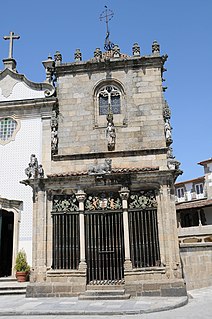
The Chapel of the Coimbras is a Manueline chapel located in the civil parish of São João do Souto, in the municipality of Braga. It has been classified as a National Monument since 1910.

The Coliseu dos Recreios is a multi-purpose auditorium located in Lisbon, Portugal.
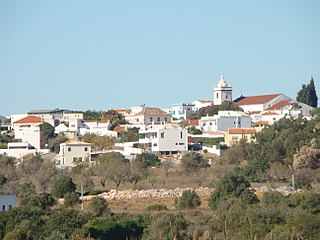
Mexilhoeira Grande is a civil parish in the municipality (concelho) of Portimão in the southern Portuguese region of the Algarve. The population in 2011 was 4,029, in an area of 91.15 km².

Coruche is a former freguesia in Aguiar da Beira Municipality, Guarda District, Portugal. It was merged with Aguiar da Beira in 2013 to form the new freguesia Aguiar da Beira e Coruche. The Portucalense Bridge over the River Coja is located in this former freguesia.

The Dolmen of Cunha Baixa is a dolmen in the civil parish of Cunha Baixa, in the municipality of Mangualde. It is located in a valley area of the Rio Castelo, between the villages of Cunha Baixa and Espinho.
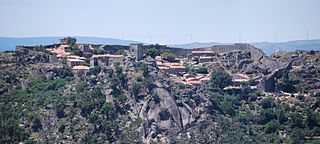
The Castle of Sortelha (Portuguese: Castelo de Sortelha is a castle in the civil parish of Sortelha in the municipality of Sabugal in the Portuguese Centro region, classified as a National Monument.

The Castle of Folgosinho, is a medieval castle in the civil parish of Folgosinho, municipality of the Gouveia in the district of Guarda in the Centre region of Portugal.
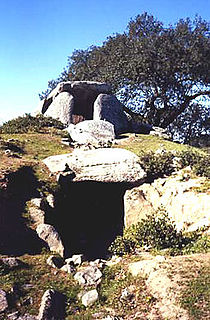
The Great Dolmen of Comenda da Igreja is a megalithic funerary site in the civil parish of Nossa Senhora do Bispo, in the municipality of Montemor-o-Novo, in the central Alentejo region of continental Portugal.

Torrão is a civil parish and town, in the municipality of Alcácer do Sal, in the Portuguese district of Setúbal, bordering on the districts of Évora and the Beja. It is crossed by the river Xarrama River. The population in 2011 was 2,295, in an area of 372.39 km².

Carapito is a freguesia in Aguiar da Beira Municipality, Guarda District, Portugal. The population in 2011 was 442, in an area of 17.26 km2. The Dolmen of Carapito I is located in this freguesia.

Aguiar da Beira is a former freguesia in Aguiar da Beira Municipality, Guarda District, Portugal. It was merged with Coruche in 2013 to form the new freguesia Aguiar da Beira e Coruche. The Pillory of Aguiar da Beira is located in this former freguesia.

The Pillory of Aguiar da Beira is a pillory located in the civil parish of Aguiar da Beira e Coruche, in the municipality of Aguiar da Beira, Portuguese district of Guarda.

The Castle of Castelo Bom, is a medieval castle in the civil parish of Castelo Bom, municipality of the Almeida in the district of Guarda in the Centre region of Portugal.
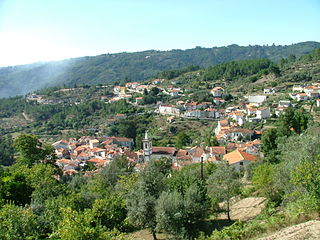
A Church of São Gião is an 18th-century church in the civil parish of São Gião, in the municipality of Oliveira do Hospital, in the Portuguese district of Coimbra. Classified as a national monument since 1910, it is locally known as the Cathedral das Beiras, although unrecognized by IGESPAR or the Diocese of Guarda.

The Anta do Monte Abraão was a megalithic dolmen located in the parish of Monte Abraão, in Queluz, Sintra Municipality, Lisbon District, Portugal. The dolmen was first identified in 1876, by Carlos Ribeiro, who carried out excavations until 1878 and published his results in 1880. Excavations suggest that it served as a tomb for about 80 individuals and that it dates back to the middle to end of the Neolithic period. The Anta do Monte Abraão and the nearby Anta da Pedra dos Mouros and Anta da Estria are collectively known as the Antas de Belas.

The Anta da Pedra dos Mouros, also known as the Anta do Senhor da Serra, is a megalithic dolmen situated near Belas and Queluz in the Lisbon District of Portugal. It is believed to date back to the late-Neolithic and early-Chalcolithic eras. The Anta da Pedra dos Mouros, the Anta da Estria, and the Anta do Monte Abraão are a short distance from each other and are collectively known as the Antas de Belas. The Anta da Pedra dos Mouros was first identified in the 1850s by Carlos Ribeiro. Despite being registered and protected as a national monument in 1910, the dolmen has recently suffered significant damage.

The Anta de Agualva, also known as the Anta do Carrascal, is a megalithic dolmen situated in an urban area of Agualva-Cacém in the municipality of Sintra, in the Lisbon District of Portugal. First identified by Carlos Ribeiro in 1875, the dolmen has recently been restored and can be easily visited.

The Anta do Alto da Toupeira, also called the Anta da Toupeira or the Anta de Salemas, is a Neolithic dolmen, or megalithic tomb, situated in the parish of Lousa in the municipality of Loures, in the Lisbon District of Portugal. It dates back to the Chalcolithic.

















